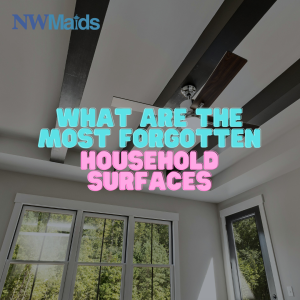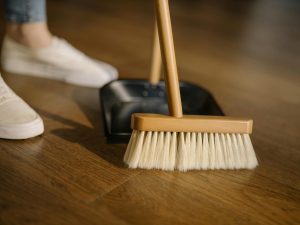Even the most organized homes have hidden cleaning spots that go untouched for weeks or even months.
Cleaning professionals often notice these overlooked areas that quietly gather dust, dirt, allergens, and bacteria, lowering both the cleanliness of a home and its indoor air quality.
These commonly forgotten surfaces affect how clean and fresh your home truly feels.
Why You Should Care About Hidden Cleaning Spots
Regularly cleaning forgotten areas in your home prevents grime buildup and helps protect surfaces and appliances.
It also creates a healthier living environment.
Knowing which areas people commonly miss while cleaning is essential for maintaining a home that is not only tidy but also safe and sanitary.
What are the Most Forgotten Household Surfaces
1. The Top of Ceiling Fans
Why It’s Missed: Ceiling fans are high and out of sight. Most homeowners only notice dust when it falls or when fans wobble.
Why It Matters: Dust on ceiling fans spreads throughout your home, reducing indoor air quality and triggering allergies.
How to Clean: Use a microfiber duster or a pillowcase to trap dust, sliding it gently over each blade. For deeper cleaning, lightly dampen a cloth with water or mild cleaner.
Frequency: Dust fans monthly; deep clean every three months.
2. Underneath Large Appliances
Why It’s Missed: Appliances like refrigerators, ovens, and washing machines are heavy and difficult to move. Once out of sight, they’re easily forgotten.
Why It Matters: Dust, crumbs, and spills collect under appliances, attracting pests and creating odors that affect your home’s cleanliness.
How to Clean: Move appliances carefully, vacuum or sweep underneath, then mop or wipe with a damp cloth.
Frequency: Clean under appliances every three to six months.
3. Door Handles and Light Switches
Why It’s Missed: We touch them constantly, so they feel clean—even when germs accumulate.
Why It Matters: These surfaces harbor bacteria and viruses, including flu and cold pathogens.
How to Clean: Wipe with disinfecting wipes or a cloth sprayed with antibacterial cleaner, covering edges and crevices.
Frequency: Weekly, or more during flu season.
4. Remote Controls and Keyboards
Why It’s Missed: Electronics are delicate, so many avoid cleaning them with liquid cleaners.
Why It Matters: Fingerprints, oils, and germs accumulate, increasing the risk of illness.
How to Clean: Use a microfiber cloth dampened with water or isopropyl alcohol, and a cotton swab for tight spots.
Frequency: Clean weekly; more often if shared.
5. Behind Toilets
Why It’s Missed: Hidden from view, this area is often ignored.
Why It Matters: Mold, bacteria, and odors develop in hard-to-reach spaces.
How to Clean: Use a long-handled scrub brush with disinfectant, cleaning corners and floor joints.
Frequency: Monthly for hygiene.
6. Shower Curtain Liners and Rods
Why It’s Missed: Curtains blend into the bathroom, noticed only when mildew appears.
Why It Matters: Moist environments foster mold, which can affect breathing and spread spores.
How to Clean: Machine wash liners or wipe with water and vinegar. Wipe rods with a damp cloth.
Frequency: Wash liners monthly; clean rods every 2–3 months.
7. Baseboards and Trim
Why It’s Missed: Low and out of sight, baseboards collect dust, pet hair, and scuffs.
Why It Matters: Dirty baseboards affect air quality and overall room cleanliness.
How to Clean: Vacuum with a brush attachment or wipe with a microfiber cloth. Use mild soap for tough grime.
Frequency: Monthly, or more in high-traffic areas.
8. Window Tracks and Sills
Why It’s Missed: Often skipped in routine cleaning.
Why It Matters: Dust and debris buildup can affect window function and promote mold growth.
How to Clean: Vacuum or brush loose dirt, then wipe with a damp cloth and mild cleaner. Use an old toothbrush for stubborn dirt.
Frequency: Quarterly, or more in dusty areas.
9. Under Furniture
Why It’s Missed: Heavy furniture makes cleaning underneath inconvenient.
Why It Matters: Dust accumulation worsens allergies and reduces vacuum effectiveness elsewhere.
How to Clean: Move furniture carefully, vacuum or sweep thoroughly, then mop hard surfaces.
Frequency: Every 1–3 months.
10. Inside Kitchen Cabinets and Drawers
Why It’s Missed: Full cabinets and drawers are rarely emptied.
Why It Matters: Crumbs and spills attract pests and create odors.
How to Clean: Remove contents, wipe with cleaner, dry thoroughly, and consider shelf liners for easier future cleaning.
Frequency: Deep clean every 3–6 months.
Conclusion: Don’t Overlook These Hidden Cleaning Spots
A truly clean home requires attention to hidden spots and overlooked areas.
From ceiling fans and drawer interiors to appliance undersides, these commonly missed zones impact health, comfort, and home air quality.
Adding these tasks to your cleaning routine keeps your home fresher, healthier, and more inviting.
For professional help in tackling those hard-to-reach areas, NW Maids specializes in cleaning hidden spots in your home, saving you time and ensuring peace of mind.
Related Posts:
- Reusable vs Disposable Cleaning Cloths: Which Works Best?
- How to Clean Grout with Hydrogen Peroxide and Baking Soda
- The Most Common Storage Mistakes People Make
- How to Choose the Best Floor Cleaner for Multi-Surface Homes


























